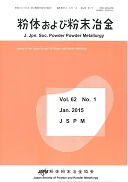巻号一覧

62 巻, 1 号
January
選択された号の論文の6件中1~6を表示しています
- |<
- <
- 1
- >
- >|
研究論文
受賞記念講演
-
小塚 久司, 大林 和重2015 年 62 巻 1 号 p. 3-9
発行日: 2015/01/15
公開日: 2015/03/31
ジャーナル オープンアクセスThe replacement of metal electrodes by conductive oxides is useful in ceramic based products. LaCo0.5Ni0.5O3−δ demonstrates high stability and high electrical conductivity with a small temperature coefficient up to 1173 K in air. The electrical conductivity of 1.9 × 103 Scm−1 is due to the high carrier concentration of 2.2 × 1022 cm−3 and the small effective mass of 0.10 me. In addition, the temperature coefficient of the conductivity is smaller than that of standard metals, and little change in oxygen content occurs up to 1173 K in air. We believe that LaCo0.5Ni0.5O3−δ is suitable as a conductive material for electrode and electrical wiring at high temperatures in air.抄録全体を表示PDF形式でダウンロード (770K)
研究論文
-
田中 公美子, 西山 勝廣2015 年 62 巻 1 号 p. 10-17
発行日: 2015/01/15
公開日: 2015/03/31
ジャーナル オープンアクセスThe effects of the addition of CeB6 on the densification and the mechanical properties of TiB2 – CeB6 composites (TCB) under the hot-pressing conditions were described. The TCB with cerium hexaboride content of 10 to 90 volume percent CeB6 were synthesized. The TCB is inexpensive and can be fabricated by a hotpressing sintering process. Addition of CeB6 and the formation of the solid-solution improved the mechanical properties of TCB. Especially, TiB2 – 30 % CeB6 composite had a bending strength of about 830 MPa and the micro-Vickers hardness of 30.5 GPa.抄録全体を表示PDF形式でダウンロード (1597K) -
村井 俊介, 荒谷 誠, 藤田 晃司, 田中 勝久2015 年 62 巻 1 号 p. 18-26
発行日: 2015/01/15
公開日: 2015/03/31
ジャーナル オープンアクセスWe have examined the Faraday effect for iron oxide thin films deposited with silver nanoparticles. The iron oxide thin films were fabricated by using an epoxide-catalyzed sol-gel method assisted by water-soluble polymers. A single spin-coating process followed by a sequence of heat treatments allows the fabrication of polycrystalline γ–Fe2O3 thin layers with a porous morphology and a transparent appearance. The sample deposited with silver nanoparticles shows optical extinction ascribed to the localized surface plasmon resonances (LSPRs) ranging from 460 − 674 nm, depending on the size of nanoparticles. The magnitude of the Faraday rotation angle is enlarged around the wavelengths of LSPRs, showing a slight redshift of the wavelength of maximum enhancement with respect to the spectral position of the LSPRs. The numerical simulation explains that the shift is caused by the difference between far-field extinction and near-field enhancement of the electric field at the surface of the nanoparticle.抄録全体を表示PDF形式でダウンロード (1967K)
研究速報
-
水内 潔, 井上 漢龍, 上利 泰幸, 杉岡 正美, 田中 基博, 武内 孝, 谷 淳一, 川原 正和 , 巻野 勇喜雄, 井藤 幹夫2015 年 62 巻 1 号 p. 27-34
発行日: 2015/01/15
公開日: 2015/03/31
ジャーナル オープンアクセスDiamond-particle-dispersed-copper (Cu) matrix composites were fabricated by spark plasma sintering (SPS) process from the mixture of diamond particles, pure–Cu and boron (B) powders. The microstructures and thermal conductivities of the composites fabricated were examined. These composites were all well consolidated at a temperature of 1173 K for 600 s by spark plasma sintering (SPS) process. No reaction at the interface between the diamond particle and the Cu matrix was observed by scanning electron microscopy and X-ray diffraction analysis for the composites fabricated under the sintering condition employed in the present study. The relative packing density of the diamond particle dispersed Cu matrix composites with B addition was 3.5~6.1 % higher than that without B addition. The thermal conductivity of the Cu/diamond composite drastically increased with B addition. The thermal conductivity of (Cu–B)–50 vol% diamond composites was 594~689 W/mK in a volume fraction range of B between 1.8 and 13.8 vol% in Cu matrix. Numerous transgranular fractures of diamond particles were observed on the bending fracture surface of diamond particle dispersed Cu matrix composites with B addition, indicating strong bonding between the diamond particle and the Cu matrix in the composite.抄録全体を表示PDF形式でダウンロード (1678K)
本会記事
-
2015 年 62 巻 1 号 p. Pref1_1-
発行日: 2015/01/15
公開日: 2015/03/31
ジャーナル オープンアクセスPDF形式でダウンロード (836K) -
2015 年 62 巻 1 号 p. Mtg1_2-Mtg1_6
発行日: 2015/01/15
公開日: 2015/03/31
ジャーナル オープンアクセスPDF形式でダウンロード (351K)
- |<
- <
- 1
- >
- >|